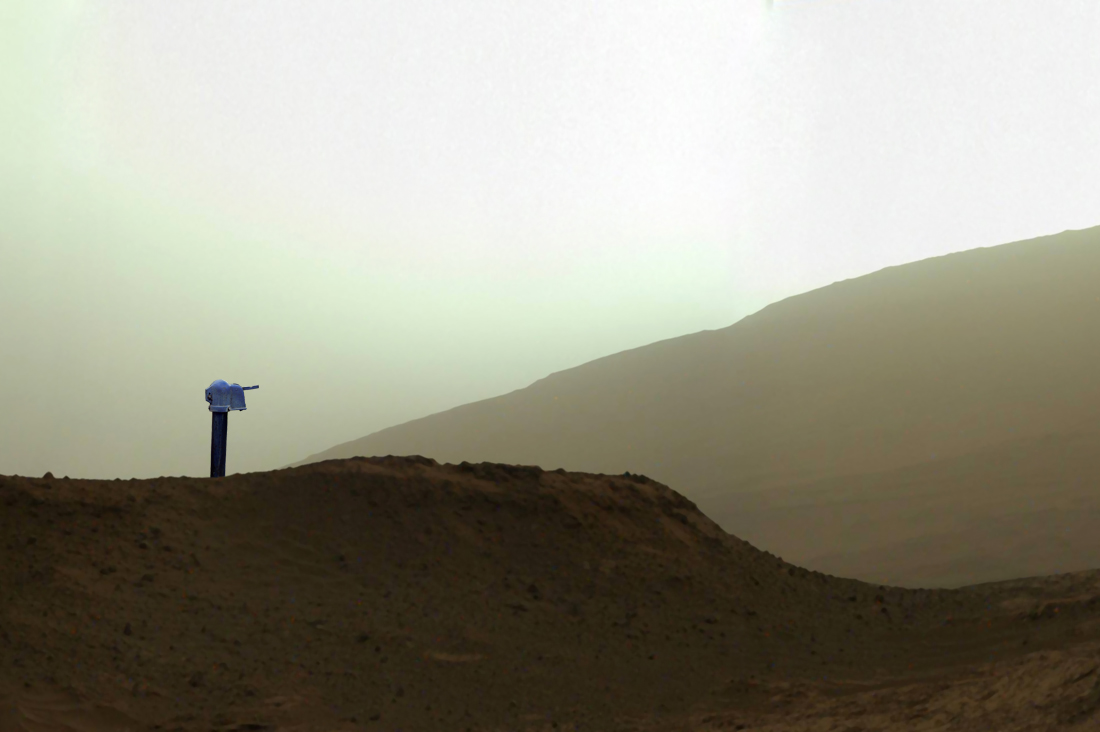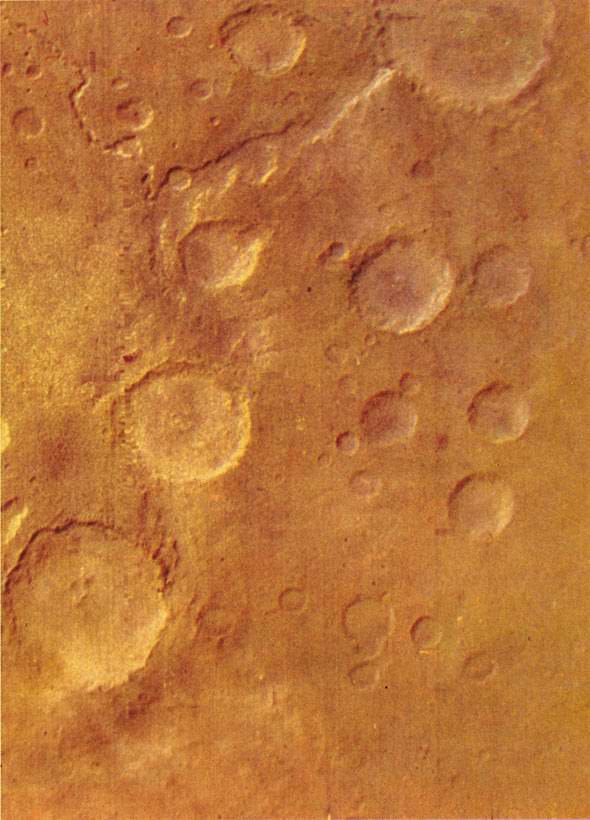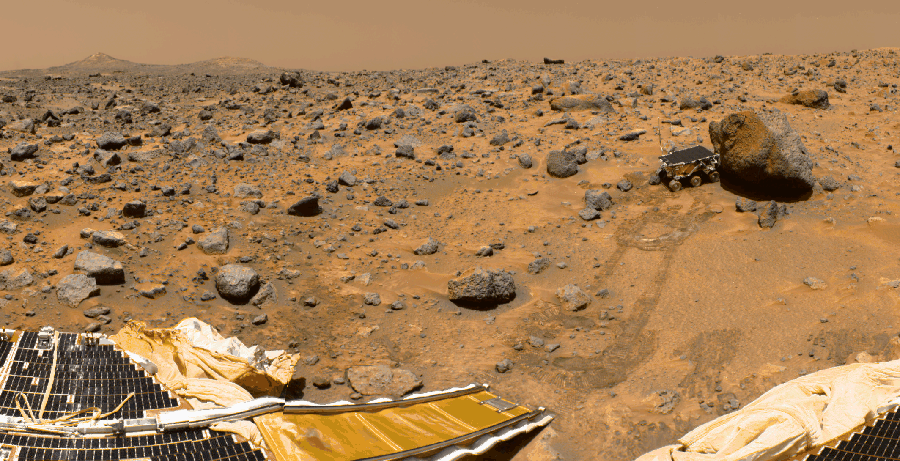Mystery of Martian Water

Water on Mars. How many copies are broken in disputes on this topic, how many books and articles are written, not very scientific. How many cartoons and demotivators are drawn ... They found water on Mars. Then again found. Then again ... And more ... Even in 2015, we’ve already found it twice, but still, every new time in the media is presented as a sensation. Let's already deal with this topic.
In the process of studying Mars, from the moment of the invention of the telescope to the present time, ideas about Martian water changed from "see the seas and oceans" to "not a drop of water", and then again to "see the ocean."
Something like this, people of Mars before the last century could see Mars in the most powerful telescopes:
')

White polar caps suggested a similarity between the poles of Mars and Earth. And dark spots seemed to someone to be oceans, and someone to jungle. In general, the world seemed quite similar to ours, it is not surprising that the Martians were densely registered in the earthly artistic culture for a century and a half.
By the middle of the twentieth century, the methods of telescopic observations improved slightly, and a photograph was added to the observations. Fewer and fewer scientists saw channels on Mars, and more and more the Red Planet seemed to be an endangered or lifeless desert. Rough attempts to calculate the surface temperature gave minus indicators up to -100 degrees Celsius, but they didn’t want to believe them.
The fat point on the Martian seas and forests was set up by the Mariner-4 spacecraft, followed by the Mariner-9 and Mars-5.

It became clear that on Mars there are no man-made canals, no traces of vegetation, or large bodies of water. Even the polar caps were covered with carbon dioxide ice.
But there were dry river beds. The discovery gave hope that the water was at least in the past, but raised questions about where it is now. However, the desert of Mars did not prevent the formation of quite modern and reliable hypotheses that seasonal changes in polar caps depend on the freezing and evaporation of carbon dioxide, but summer residues that do not change from pole to pole from year to year are water ice.

This was written in the Great Soviet Encyclopedia in 1968.
The first studies of the Martian soil from the surface gave negative results. NASA Viking descent vehicles in the 70s. they landed in the middle latitudes of the northern hemisphere of Mars, and had to not only determine the presence of microorganisms in the ground, but also find out whether there is water in it. The results were not encouraging, the gas chromatograph of the devices determined only 1% of moisture.

The next stage of the search took place already in the 90s. From orbit, the Mars Global Surveyor satellite captured even more evidence of Mars’s water past. For example, the classic river delta in the crater Eberswalde.

Once there was a lake in a crater into which a river flowed. Particles of soil, drawn by the current, settled in the lake to form multilayer sediments. This crater and the delta are considered as one of the future possible targets for the study by rovers.
In 1997, the Mars Pathfinder launch module with the ancestor of all NASA rovers, Sojourner, landed on Mars. He was sent to an area that from space looked like a wide bed of a huge river, like a dried up Amazon.

Unfortunately for many, on the surface practically nothing indicated the effect of water. The plain was covered with volcanic boulders and sand. Sojourner was able to identify traces of water exposure in some stones, but very little.

After the first failures of the Martian water began a full-scale hunt. The NASA Mars Odyssey satellites were launched into orbit in 2001, and ESA Mars Express. On both devices were placed various research tools for finding water, including Russian-made.

Mars Odyssey was equipped with a GRS gamma detector and a neutron detector (HEND from the Space Research Institute of the Russian Academy of Sciences). They caught cosmic gamma radiation and neutrons reflected from the surface of Mars. The hydrogen atoms contained in the near-surface layers of the soil, retain neutrons and emit gamma photons under the impact of cosmic particles, which allows to determine the approximate hydrogen content. Since gas will not linger there, hydrogen can only be in a bound form, most often in water molecules.
Two devices allowed us to make the first maps of the proposed distribution of water in the ground of Mars.


It turned out not so bad. Water is still there. The devices confirmed each other, but I wanted to see the water directly, "touch" and analyze.
Distinguish water ice from carbon dioxide at the poles managed device OMEGA, on the satellite Mars Express. This spectrometer could see the surface layer (pink in the image) of frozen CO2, and blue ice H2O (blue) in deep crevices.

By 2005, Mars Express had deployed MARSIS radar antennas, which could "see through" the crust of Mars to a depth of several kilometers. This radar could make "ultrasound" of the Martian polar caps and get their profiles "in section".

Thanks to this research, it was possible to determine that water ice on the north polar cap was deposited up to 1.7 km thick, and to the south - up to 4 km. Carbon dioxide ice turned out to be only a few meters thick - up to 8 at the South Pole. Moreover, the radar received data in several areas, where the reflection of radio waves can be interpreted as a reflection from a liquid reservoir. Those. there is still some hope of finding on Mars a counterpart of the Earth’s subglacial Antarctic Lake Vostok . And if someone else hopes to find a Martian life, this is the right place. However, there is no definite certainty that someone lives in the earthly East, so it is not known whether anyone could survive in the likely Martian.
Meanwhile, in 2004, a pair of rovers, Spirit and Opportunity, landed on Mars. They were sent to where they expected to find and investigate parts of the terrain that survived the significant effects of water.
Opportunity landed on the plain of Meridian where there was a high concentration of hematite. This form of iron ore is formed under the influence of groundwater or at the bottom of shallow lakes.
Spirit was sent to the crater Gusev, where they expected to find traces of a river, lake or even a sea bay.

Ironically, Opportunity accomplished almost all of the original goals, barely set foot on the surface of Mars. He found hematite, found layered deposits, found imprints of salt crystals that remained when the reservoir dried out. From the surface, he was able to confirm what was already clear - there was once water on Mars, and the physical conditions allowed it to remain liquid. Those. Mars was once warmer, and had a denser atmosphere.

Subsequently, scientists had to drive Opportunity across the plain in order to find him a new suitable target for research. This goal was the clay, which could be deposited only in fresh water. Previously, the rover came across only signs of salt and acid water bodies that are not very suitable for life in them.
He found clay too. Overcame a marathon distance of 42 km and recently exchanged a four thousandth Martian day. Work continues.
Spirit lived a short but stormy life. At first did not find any signs of water activity on the surface. Then, after 5 kilometers, and thanks to the broken "leg", he found signs of the once-existing ancient geysers. At the end of his career, Spirit found another sign of a dry reservoir - a pile of salt in the pit. This salt and became his grave.

Continued .
In the next series, you will learn how much water is left on Mars, where to look for it except for the poles, and where spring streams come from.
Source: https://habr.com/ru/post/374971/
All Articles